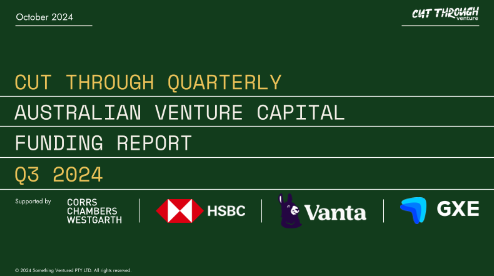News and Announcements

The Changing Landscape of Capital Raising: Key Insights from the Cut Through Venture Quarterly Report
- Published October 09, 2024 11:18PM UTC
- Publisher Steve Torso
- Categories Capital Insights, Landing, Trending
One of my favourite reports each quarter is the Cut Through Venture report. It consistently provides a clear snapshot of the innovation ecosystem, revealing the key trends and challenges that startups and investors are navigating. The Q3 2024 edition was no exception, offering data-driven insights into how the venture capital landscape is evolving.

Capital Raised: A Sharp Decline – A Different Perspective
A notable takeaway from the report is the significant drop in capital raised, totalling just $695 million in Q3 2024. This represents a sharp decline compared to the previous quarter, reflecting a tightening funding environment. The drop is primarily attributed to the absence of mega-deals over $100 million, which had sporadically boosted previous quarters.
Looking ahead, I believe this reduced capital will become a common story for most software businesses. However, there will be exceptions, particularly in sectors like fintech, where companies involved in lending or insurance may continue to require substantial capital to meet their growth needs.
One reason for this trend is clear: labour costs. For most companies, their biggest line item is staff. However, the need for large teams with layers of middle managers, coordinators, and supervisors is rapidly diminishing. Companies are learning to do more with less, and this shift will only intensify with the growing use of AI agents. As the report notes, portfolio companies are consistently reducing headcount, and they are often not replacing those who leave. This trend is expected to continue for the foreseeable future.
Exits: Challenges and New Opportunities in Secondaries
Another key point raised in the report is the growing challenge of exits. Traditional exit strategies, such as IPOs and large-scale mergers, are proving difficult to achieve in the current market. The report highlights that nearly half of venture capital firms are now discussing exits more frequently than a year ago, reflecting a growing pressure to return capital to investors.
With fewer IPOs and large acquisitions, secondary transactions have emerged as a vital exit route. In Q3 2024, secondary sell-downs were increasingly common, offering a way for early investors to exit while allowing the company to maintain its growth trajectory. This type of exit is particularly appealing to strategic and private equity buyers, who are now acquiring stakes in companies at earlier stages than before. For platforms like Wholesale Investor and CapitalHQ, this shift opens opportunities to facilitate more secondary deals, helping investors and founders secure much-needed liquidity.
Profitability: A Renewed Focus
Until 2022, significant cash burns were almost the norm for startups, with companies prioritising rapid growth over financial sustainability. However, as the report points out, the landscape is changing. Time-to-profitability is now expected to shorten as founders focus more on achieving profitability sooner rather than later.
This shift is already becoming evident in how startups manage their burn rates. In Q3 2024, 58% of investors rated the quality of deal flow as good or excellent, but they are increasingly looking for companies with a clear path to profitability. Startups are moving away from the growth-at-all-costs mentality, becoming more mindful of how they use capital, particularly given the challenges of raising significant rounds in the current environment.
For founders, this means building leaner operations with an eye on profitability from an earlier stage. Investors are also adjusting their expectations, with a greater emphasis on capital efficiency and the ability to sustain growth without needing continuous injections of external capital.
Looking Forward
As the Cut Through Venture report highlights, the capital raising environment is shifting. The reduced capital raised in Q3 2024, coupled with the increased focus on secondary exits and profitability, paints a picture of a more cautious and measured market. While challenges remain, these trends are also creating new opportunities for both founders and investors.
For platforms like Wholesale Investor, this evolving landscape presents an opportunity to play a pivotal role in connecting startups with investors, especially through secondary market transactions. As the focus shifts from high cash burns to profitability and sustainable growth, founders will need to adapt their strategies—and platforms like ours can be key to supporting them through these changes.
It’s clear that the last few years have been challenging for raising capital, but as this report shows, the market is adjusting, and a new, more efficient startup ecosystem is beginning to take shape. It will be fascinating to see how these trends continue to unfold and how companies rise to the challenge of securing both funding and liquidity in this new environment.
Trending
Backed By Leading Investment Groups and Family Offices







